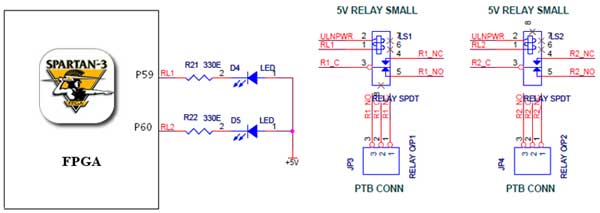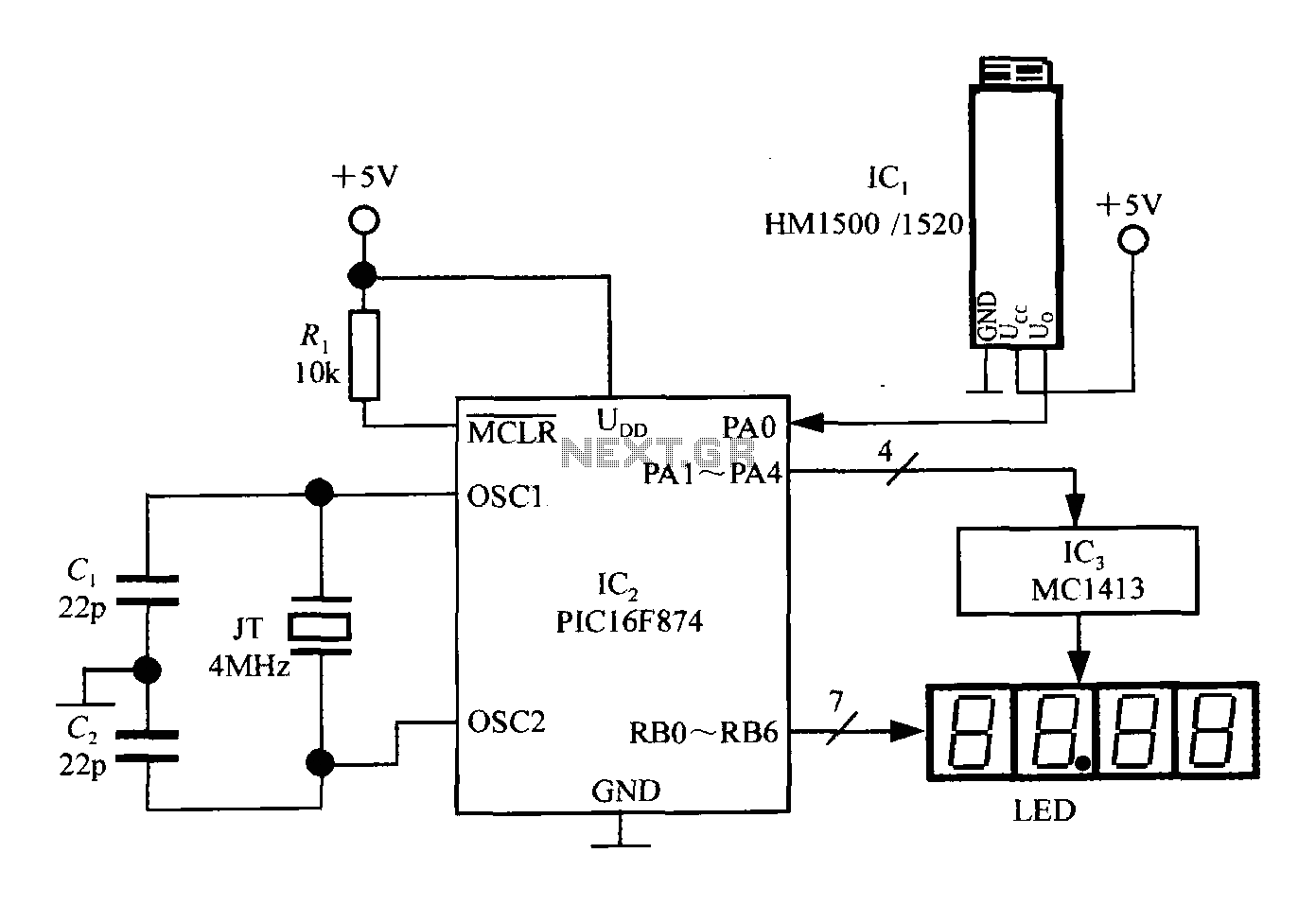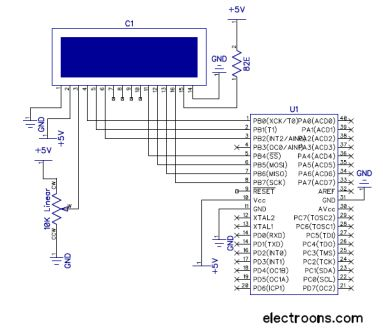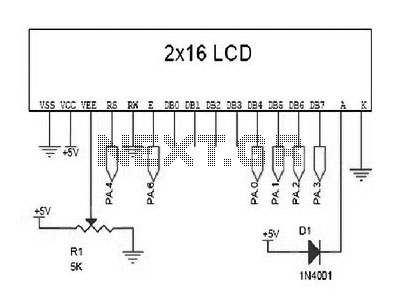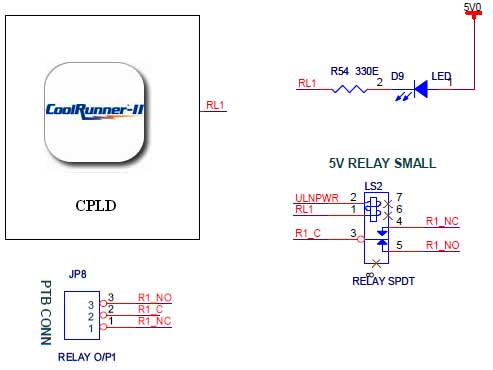
interfacing to microprocessor
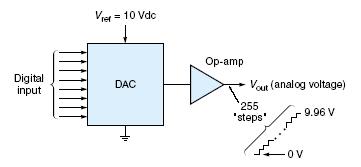
The parallel interface transfers data in 8 bits (or more) simultaneously, utilizing eight separate wires. It serves as an extension of the data bus to external devices. This interface is particularly suitable for devices that operate in binary states, such as limit switches and motors which require simple on/off signals. Each of these signals is classified as a logic variable, and a single 8-bit port can transmit eight such signals. In different applications, controllers may employ a parallel interface to connect with analog devices, like variable-speed DC motors. In such instances, the binary output from the controller must first undergo conversion to an analog voltage to drive the motor. This conversion is executed by a digital-to-analog converter (DAC), which transforms a digital word into an analog voltage. While the internal mechanics of the DAC are not covered in this text, a basic understanding of its operational parameters is beneficial. A typical 8-bit DAC is represented in a block diagram. The input consists of an 8-bit digital word, while the output is a current proportional to the binary input, which must then be converted into a voltage using an operational amplifier (op-amp). A stable reference voltage (Vref) is necessary for the DAC, establishing the maximum analog voltage output; for instance, a digital input of 11111111 results in an output voltage equivalent to Vref, whereas an input of 00000000 yields 0 Vdc. Intermediate values produce output voltages that are linearly proportional to Vref. Resolution is a critical factor in digital-to-analog conversion, defined as the maximum error during the conversion process. This error arises because digital representations can only convey discrete values, as illustrated by a stair-step diagram. For an 8-bit number, the maximum value is 255 decimal, leading to 255 potential output voltage steps. The difference between these steps is determined by the least significant bit (LSB). Therefore, for 8-bit data, the resolution is 1 part in 255, or approximately 0.39%. This resolution suffices for numerous applications, but for those requiring higher precision, two or more 8-bit ports can be combined to yield 16 bits of data, with a maximum decimal value of 65,535. An 8-bit DAC, such as the DAC0808, is typically available in a 16-pin dual in-line package (DIP) and necessitates an external op-amp (like the LF 351), along with two resistors and a capacitor to complete the circuit. It operates on both positive and negative supply voltages, with a conversion time of 150 nanoseconds. Conversely, an analog-to-digital converter (ADC) is responsible for converting an analog voltage into a digital word. Typically, an ADC comprises a single integrated circuit (IC) along with a few supporting components. The process of analog-to-digital conversion is more complex than that of a DAC, requiring a conversion time usually in the microsecond range, influenced by the ADC type, applied clock frequency, and the number of bits being converted. An 8-bit ADC block diagram illustrates that the input voltage (Vin) can range from 0 V to Vref; a Vin of 0 Vdc results in an output of 00000000, while a Vin of Vref produces an output of 11111111 (255 decimal). To initiate the conversion, a start-conversion pulse is sent to the ADC, which samples the analog input and converts it to binary. Upon completion, the ADC activates the output. An example of an 8-bit ADC is the ADC0804, which is packaged as a 20-pin DIP and operates on a single 5-Vdc supply.
The parallel interface functions as a robust communication method for transferring multiple bits of data concurrently, making it particularly advantageous in applications requiring quick and efficient data transfer. Each wire in the parallel interface corresponds to a bit in the data word, allowing for simultaneous transmission of multiple signals. This configuration is beneficial in scenarios where rapid state changes are required, such as in control systems for motors or sensors.
The DAC plays a critical role in converting digital signals into analog form, which is essential for interfacing with analog devices. The operational amplifier in conjunction with the DAC ensures that the current output is transformed into a usable voltage level. The precision of the conversion is directly linked to the resolution of the DAC, which determines how finely the output can be adjusted. As applications demand higher fidelity and finer control, utilizing multiple DACs in tandem can enhance performance by increasing the resolution and range of output voltages.
Similarly, the ADC serves an equally important function in converting analog signals back into digital format, enabling digital processing of real-world signals. The complexity of the ADC operation reflects the need for precise timing and sampling to ensure accurate representation of the input voltage. The relationship between the analog input and the digital output is crucial for applications such as data acquisition systems, where accurate measurements are paramount.
Overall, the integration of DACs and ADCs with parallel interfaces provides a comprehensive solution for interfacing digital systems with the analog world, facilitating a wide range of applications in electronics and control systems.The parallel interface transfers data 8 bits (or more) at the same time, using eight separate wires. It is essentially an extension of the data bus into the outside world. The parallel interface is ideal for inputting or outputting data from devices that are either on or off. For example, a single limit switch uses only one input bit, and an on-of f signal to a motor requires only one output bit. These 1-bit signals are called logic variables, and eight such signals can be provided from a single (8-bit) port. This concept In other applications, the controller may use a parallel interface to connect to an analog device ”for example, driving a variable-speed DC motor.
In such a case, the binary output of the controller must first be converted into an analog voltage before it can drive the motor. This operation is performed by a special circuit called a digital-toanalog converter. The digital-to-analog converter (DAC) is a circuit that converts a digital word into an analog voltage.
It is not within the scope of this text to describe the internal workings of the DAC, but a general understanding of the operating parameters is appropriate. Figure 2. 5 shows the block diagram of a typical 8-bit DAC. The input is an 8-bit digital word. The output is a current that is proportional to the binary input value and must be converted to a voltage with an op-amp.
A stable reference voltage (Vref) must be supplied to the DAC. This voltage defines the maximum analog voltage ”that is, for a digital input of 11111111, Vout is essentially Vref. If the input is 00000000, the Vout will be 0 Vdc. For all values in between, the output voltage is a linear percentage of Vref. Specifically, the output voltage for any digital input (for the 8-bit DAC) is An important consideration of digital-to-analog conversion is resolution.
The resolution of a DAC is the worst case error that is introduced when converting between digital and analog. This error occurs because digital words can only represent discrete values, as indicated by the stair-step diagram in Figure 5.
For example, the maximum value of an 8-bit number is 255 decimal, which means there are 255 possible steps of the output voltage. The difference between steps is the value of the least significant bit (LSB). Because the smallest increment is one step, the resolution (for 8-bit data) is 1 part in 255, or 0. 39%. This resolution is adequate for many applications, but if more is needed, two (or more) 8-bit ports can be used together.
Two ports provide 16 bits of data. The maximum decimal value of 16 bits is 65, 535. Being able to divide an analog Figure 6 shows a data sheet for an 8-bit DAC (DAC0808). This device comes as a 16-pin DIP (dual in-line package) and uses an external op-amp (such as the LF 351), two resistors, and a capacitor to complete the circuit. It requires plus and minus powersupply voltages. The time to complete a conversion is a fast 150 ns (nanoseconds). (The An analog-to-digital converter (ADC) is a circuit that converts an analog voltage into a digital word.
A typical ADC consists of a single IC with a few support components. Analog-to-digital conversion is a more complicated process (than for the DAC), and the hardware requires some conversion time, which is typically in the microsecond range. The conversion time required depends on the type of ADC, the applied clock frequency, and the number of bits being converted.
Figure 2. 7 shows a block diagram for an 8-bit ADC. The input Vin can be any voltage between 0 V and Vref. When Vin is 0 Vdc, the output is 00000000; when Vin is Vref, the output is 11111111 (255 decimal). To start the conversion process, a start-conversion pulse is sent to the ADC. The ADC then samples the analog input and converts it to binary. When completed, the ADC activates Figure 8 shows a data sheet for an 8-bit ADC (ADC0804). Packaged as a 20-pin DIP, this device can operate on a single 5-Vdc 🔗 External reference
The parallel interface functions as a robust communication method for transferring multiple bits of data concurrently, making it particularly advantageous in applications requiring quick and efficient data transfer. Each wire in the parallel interface corresponds to a bit in the data word, allowing for simultaneous transmission of multiple signals. This configuration is beneficial in scenarios where rapid state changes are required, such as in control systems for motors or sensors.
The DAC plays a critical role in converting digital signals into analog form, which is essential for interfacing with analog devices. The operational amplifier in conjunction with the DAC ensures that the current output is transformed into a usable voltage level. The precision of the conversion is directly linked to the resolution of the DAC, which determines how finely the output can be adjusted. As applications demand higher fidelity and finer control, utilizing multiple DACs in tandem can enhance performance by increasing the resolution and range of output voltages.
Similarly, the ADC serves an equally important function in converting analog signals back into digital format, enabling digital processing of real-world signals. The complexity of the ADC operation reflects the need for precise timing and sampling to ensure accurate representation of the input voltage. The relationship between the analog input and the digital output is crucial for applications such as data acquisition systems, where accurate measurements are paramount.
Overall, the integration of DACs and ADCs with parallel interfaces provides a comprehensive solution for interfacing digital systems with the analog world, facilitating a wide range of applications in electronics and control systems.The parallel interface transfers data 8 bits (or more) at the same time, using eight separate wires. It is essentially an extension of the data bus into the outside world. The parallel interface is ideal for inputting or outputting data from devices that are either on or off. For example, a single limit switch uses only one input bit, and an on-of f signal to a motor requires only one output bit. These 1-bit signals are called logic variables, and eight such signals can be provided from a single (8-bit) port. This concept In other applications, the controller may use a parallel interface to connect to an analog device ”for example, driving a variable-speed DC motor.
In such a case, the binary output of the controller must first be converted into an analog voltage before it can drive the motor. This operation is performed by a special circuit called a digital-toanalog converter. The digital-to-analog converter (DAC) is a circuit that converts a digital word into an analog voltage.
It is not within the scope of this text to describe the internal workings of the DAC, but a general understanding of the operating parameters is appropriate. Figure 2. 5 shows the block diagram of a typical 8-bit DAC. The input is an 8-bit digital word. The output is a current that is proportional to the binary input value and must be converted to a voltage with an op-amp.
A stable reference voltage (Vref) must be supplied to the DAC. This voltage defines the maximum analog voltage ”that is, for a digital input of 11111111, Vout is essentially Vref. If the input is 00000000, the Vout will be 0 Vdc. For all values in between, the output voltage is a linear percentage of Vref. Specifically, the output voltage for any digital input (for the 8-bit DAC) is An important consideration of digital-to-analog conversion is resolution.
The resolution of a DAC is the worst case error that is introduced when converting between digital and analog. This error occurs because digital words can only represent discrete values, as indicated by the stair-step diagram in Figure 5.
For example, the maximum value of an 8-bit number is 255 decimal, which means there are 255 possible steps of the output voltage. The difference between steps is the value of the least significant bit (LSB). Because the smallest increment is one step, the resolution (for 8-bit data) is 1 part in 255, or 0. 39%. This resolution is adequate for many applications, but if more is needed, two (or more) 8-bit ports can be used together.
Two ports provide 16 bits of data. The maximum decimal value of 16 bits is 65, 535. Being able to divide an analog Figure 6 shows a data sheet for an 8-bit DAC (DAC0808). This device comes as a 16-pin DIP (dual in-line package) and uses an external op-amp (such as the LF 351), two resistors, and a capacitor to complete the circuit. It requires plus and minus powersupply voltages. The time to complete a conversion is a fast 150 ns (nanoseconds). (The An analog-to-digital converter (ADC) is a circuit that converts an analog voltage into a digital word.
A typical ADC consists of a single IC with a few support components. Analog-to-digital conversion is a more complicated process (than for the DAC), and the hardware requires some conversion time, which is typically in the microsecond range. The conversion time required depends on the type of ADC, the applied clock frequency, and the number of bits being converted.
Figure 2. 7 shows a block diagram for an 8-bit ADC. The input Vin can be any voltage between 0 V and Vref. When Vin is 0 Vdc, the output is 00000000; when Vin is Vref, the output is 11111111 (255 decimal). To start the conversion process, a start-conversion pulse is sent to the ADC. The ADC then samples the analog input and converts it to binary. When completed, the ADC activates Figure 8 shows a data sheet for an 8-bit ADC (ADC0804). Packaged as a 20-pin DIP, this device can operate on a single 5-Vdc 🔗 External reference

